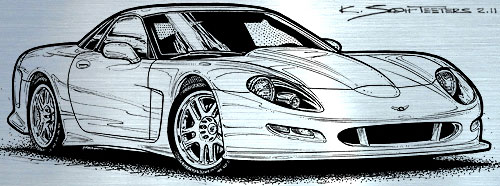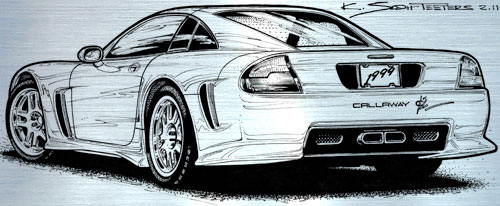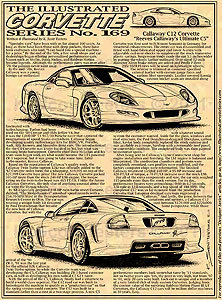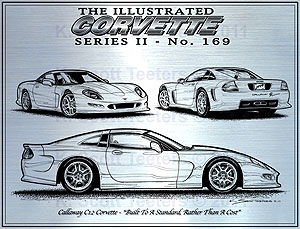“Build To Standard, Rather Than A Cost”
“Specialty cars” have been with us for almost 100 years. As long as there have been those with deep pockets, there have been craftsmen who said, “I can build you a special machine – for a price.” By the end of the ‘60s, a few small shops and car dealerships began offering personalized performance cars. Names such as Shelby, Dana, Nickey, and Baldwin-Motion became legends. Although the performance party was over after ‘70, the passion never went away.
In the mid-’70s, Reeves Callaway was a young foreign car enthusiast fascinated with turbocharging. Turbos had been used on the ‘60 Corvair and Olds Jetfire V8, but it was the 1,000-HP ‘73 917/30 Porsche racer that captured the imaginations of speed freaks everywhere. Callaway began developing quality turbocharger kits for BMW, VW, Porsche, Audi, Alfa Romero, and Mercedes-Benz cars. The introduction of the the C4 Corvette was a very big deal in ‘84, but what was missing brute horsepower. Corvette chief Dave McLellan and his team soon began work on what would become the LT5-powered ZR-1 supercar, but it was going to take some time. Enter turbo-master, Reeves Callaway.
Based on the reputation of Callaway’s quality work, the Callaway Twin Turbo (option B2K) was officially added to the ‘87 Corvette order form, for a whopping, $19,995 on top of the $27,999 Corvette base price! The new Callaway Corvette packed 105-HP more than the stock 240-HP L98 engine. The torque rating on the twin-turbo beast was 465 FT/LB. Unlike the future Callaway Corvettes, the only clue of anything unusual about the car were the Dymag wheels.
In ‘88 a specially prepared 898-HP twin-turbo street Corvette, dubbed, “The Sledgehammer” smashed speed records with a 254.76-MPH blast at the Transportation Research Center in Ohio. The car was wearing a unique body kit designed by Paul Deutschman that became the new look of Callaway Corvettes. But with the arrival of the ‘90 ZR-1, ‘91 was the last year for the official B2K Callaway Twin-Turbo option. So while the Corvette team was developing the C5, Callaway was building ZR-1-based customer cars, as well as developing his own radical C7 GT1 racer.
With the arrival of the C5, Callaway finally had a structure to build a world-class supercar. The C12 road car was built to homologate the machine to qualify as a “production car” so that the racing version could compete. The C12 was built to a standard rather than a cost in a two-stage process. A new C5 Corvette was first sent to IVM (now Semcon) in Germany for structural enhancements. The entire car was disassembled and fitted with hand-fabricated upper and lower A-arms with adjustable coil-over-shocks to supplement the stock transverse plastic springs. Suspension mods made the car 5.1-inches wider by putting the wheels farther outboard. Over-sized 12-inch diameter Alcon brake rotors are added and Pirelli P-Zero 295/30ZR19 tires will be used on lightweight wheels.
The interior is trimmed in customer specified colored leather with custom gauge faces and carbon fiber surrounds. Leather covered Koenig custom bucket seats are installed along with whatever sound system the customer wanted. Aside for the glass, windows and roof structure, the Paul Deutchman-designed fiberglass, carbon fiber, Kevlar body completely replaced the stock exterior and was available as a coupe, hardtop with a removable roof panel, or convertible/roadster. The completed body was then painted to customer specs.
After being sent to Callaway’s Lyme Connecticut shop for engine installation and finishing, the LS1 engine is balanced and blueprinted. The combustion chambers and pistons were completely reworked, cam profiles were modified, and the factory computer chips were reformatted. The finished Callaway treatment yielded 440-HP, a 95-HP increase and 420-FT/LB of torque, a 70-FT/LB increase over the stock L98.
For all of the extra components and size, the car only weighed 135-pounds more than the stock version. For its day, performance figures were astonishing.; 0-60 in 4.2-seconds, 1/4-mile in 12.8-seconds, and a top speed of 188-MPH. The completed C12 was so far removed from the production Corvette that European destined cars were registered a “Callaway.” And lastly, the price. Between the variations and options, a Callaway C12 cost between $170,000 and $220,000.
Some perspective. While those performance numbers look somewhat tame by ‘11 standards, not so twelve years ago. Yes, the price is very high, but from ‘97 to ‘01, only 20 cars were built. Each car is unique and a member of a very limited club of truly custom Corvettes. Judging from the current value of the surviving Baldwin-Motion Phase III GT Corvettes, the Callaway C12 cars will be million dollar machines in 30 years. Easy.
Scott
PS – Prints of the above article are available HERE.






